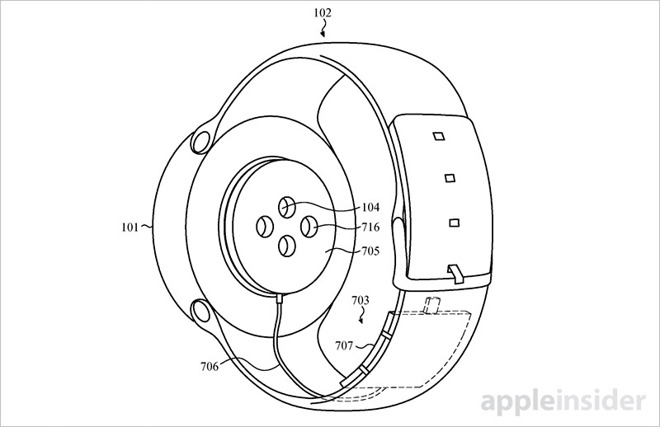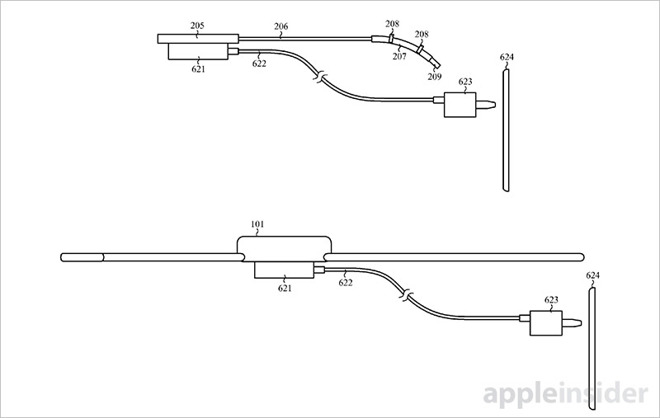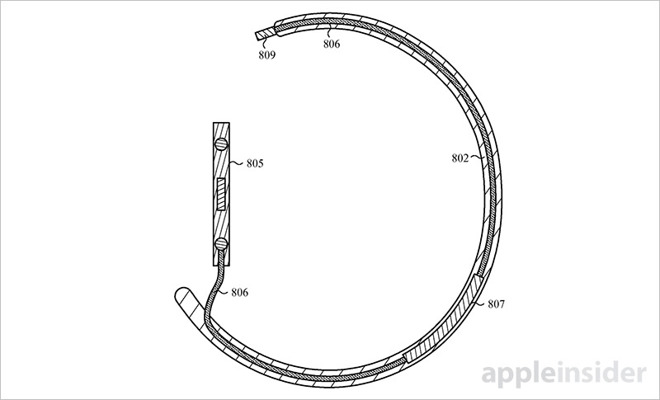While third-party companies have promised —but not delivered —an Apple Watch band capable of charging the device while it's being worn, Apple in a patent application on Thursday details a wearable battery module that juices Watch up via inductive power transmission.


As published by the U.S. Patent and Trademark Office, Apple's "Charging apparatus for wearable electronic device" lays the groundwork for designing and manufacturing an inductive Apple Watch charger that is either embedded in a strap accessory or attaches itself onto an existing band.

Like other portable charging devices, the power apparatus described in today's application features one or more cells for fully or partially charging Watch's internal battery. Unique to Apple's solution is the use of inductive power transfer, a technology already deployed in the Apple Watch Magnetic Charging Cable included with every Apple Watch purchase.
A two-way design, Apple's portable charging module features an inductive power transfer component, or inductive coil, good for transmitting power to Watch or accepting power to top off its internal batteries. To help align the inductive coils, and thus boost efficiency, magnets are disposed in the battery pack's charging plate.
Other embodiments include contingencies for charging the external device via Lightning —including, interestingly, a "miniaturized" Lightning —connector, USB, mini-USB or other hard-wired interface. Even the most advanced inductive charging methods lack the power transfer capabilities of wired solutions. Including both inductive and wired options allows users to recharge the battery pack using their existing Magnetic Charging Cable or directly from a wall adapter or Mac.
As for daily wear, Apple proposes fitting the battery module under a Watch band or beneath the device chassis. This arrangement helps protect sensitive internal components and more aesthetically pleasing than clipping the apparatus to an outer band surface.
Alternatively, conductors, battery cells and other components within the external power pack can be curved or made from flexible material so as to better accommodate insertion into an Apple Watch band. This last design feature would also allow Apple to completely embed the charging device directly into an Apple Watch band accessory, perhaps for individual sale or as part of a band/battery package.
To accommodate Apple Watch's existing biometric sensor suite, which exists as a bank of optical sensors on the device's underside, the battery design calls for apertures or translucent windows to be formed in the inductive head unit to allow for the passage of light.
As can be expected from an inductive system, Apple's power module is capable of generating heat at levels that might be of concern to users, especially in a design meant to be worn next to the skin. To limit discomfort and potential failure of heat-sensitive components, the invention utilizes circuitry to regulate the flow of power during use.
The unit also incorporates sensors, or in some embodiments electrical contacts, capable of detecting a user's body. This means the device can limit charge rates when Watch is being worn and boost rates when it is not.
Whether Apple plans to bring an external Apple Watch charging device to market remains unknown, but the company is keen on extending the operating life of the wearable without compromising its sleek design. For example, the Apple Watch Series 2 is only slightly thicker than its predecessor, but contains a more capacious battery and efficient S2 SoC to make up for power-hungry components like a GPS radio.
Apple's portable Apple Watch battery patent application was first filed for in July 2015 and credits Gregory S. Adamisin as its inventor.
No comments :
Post a Comment